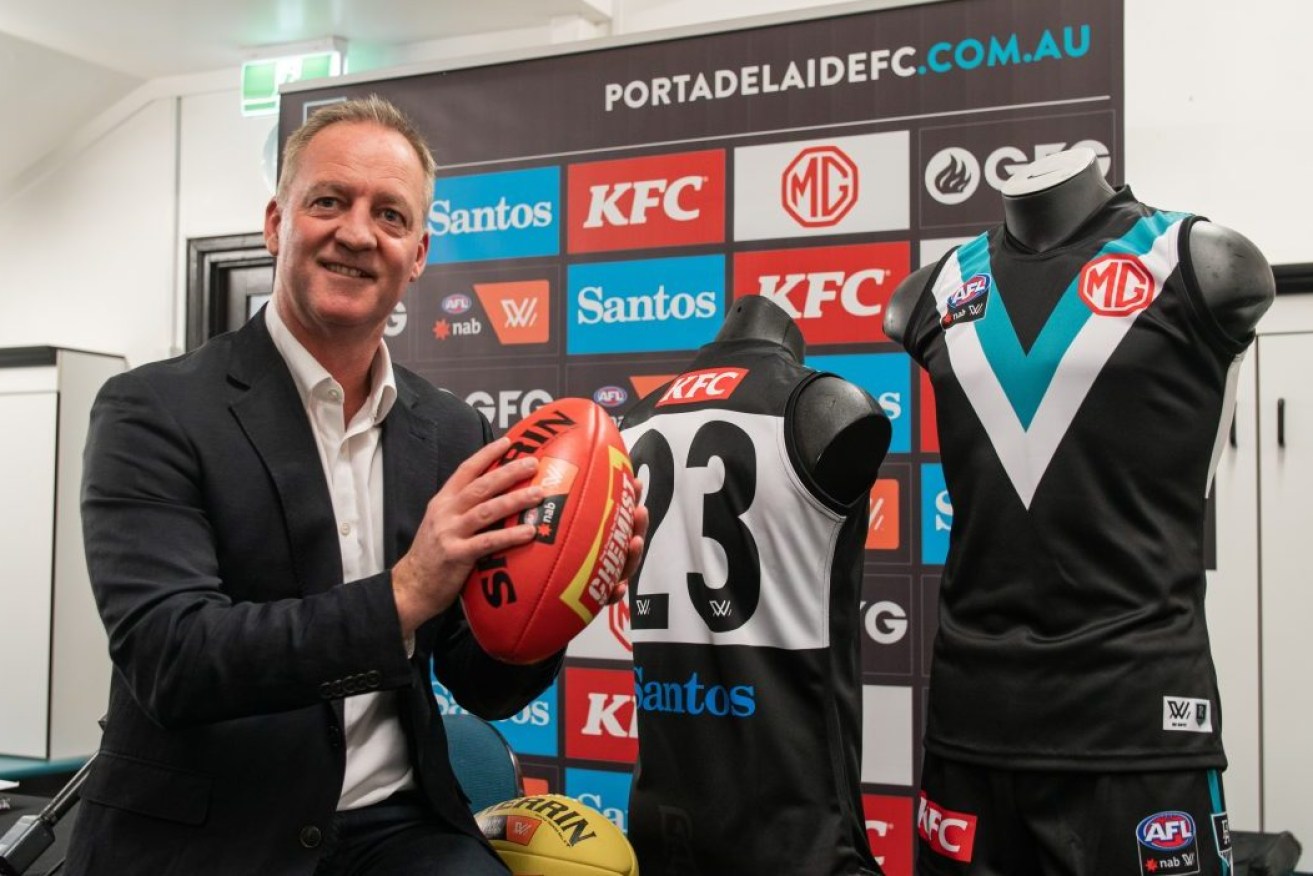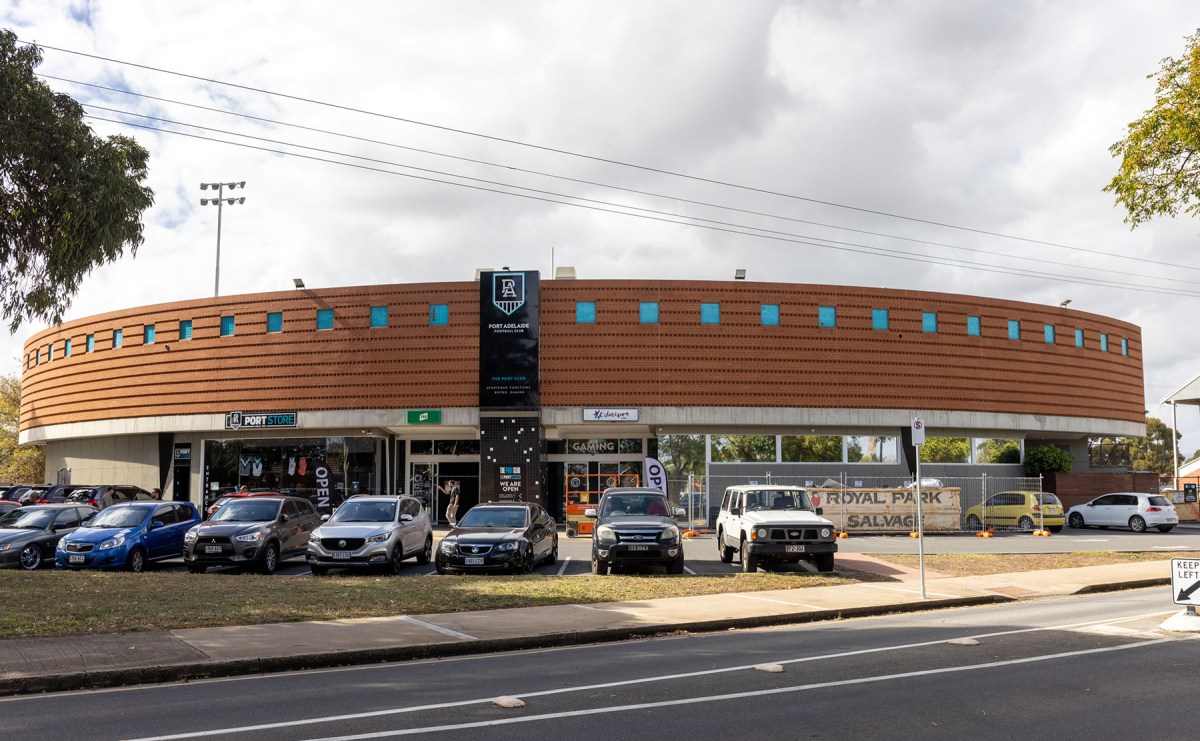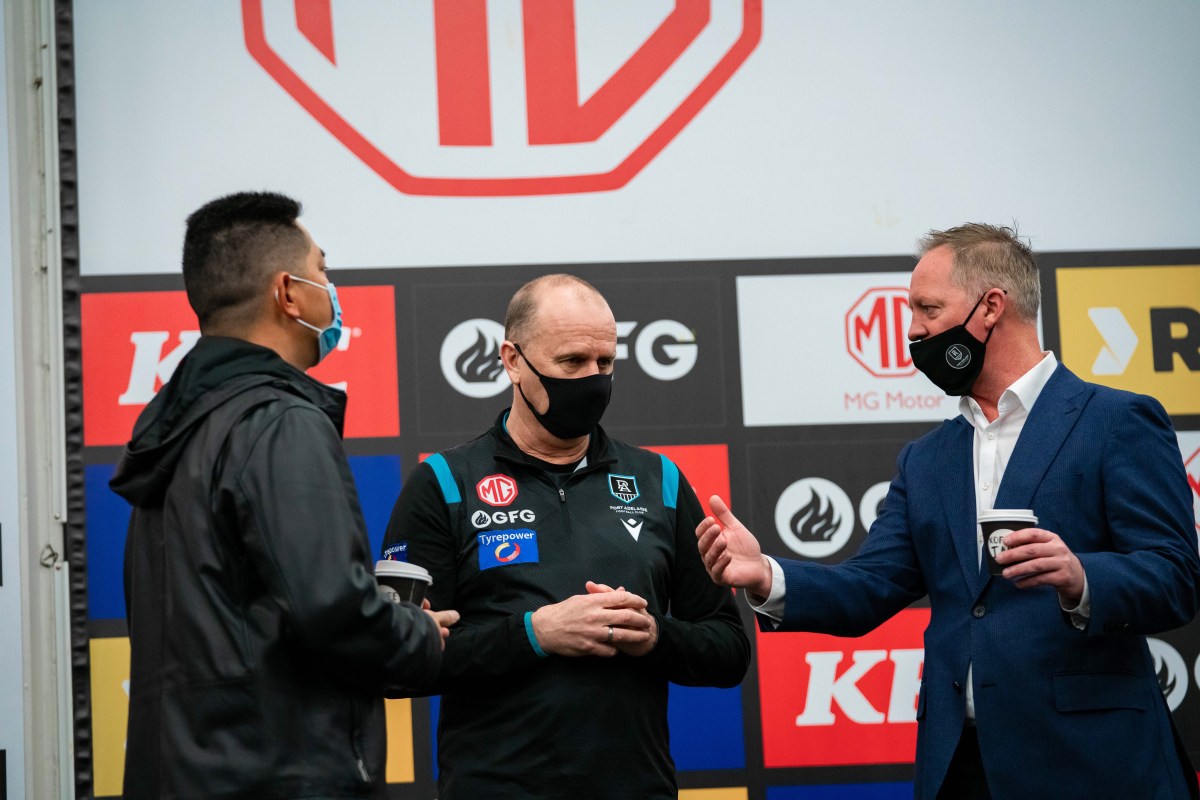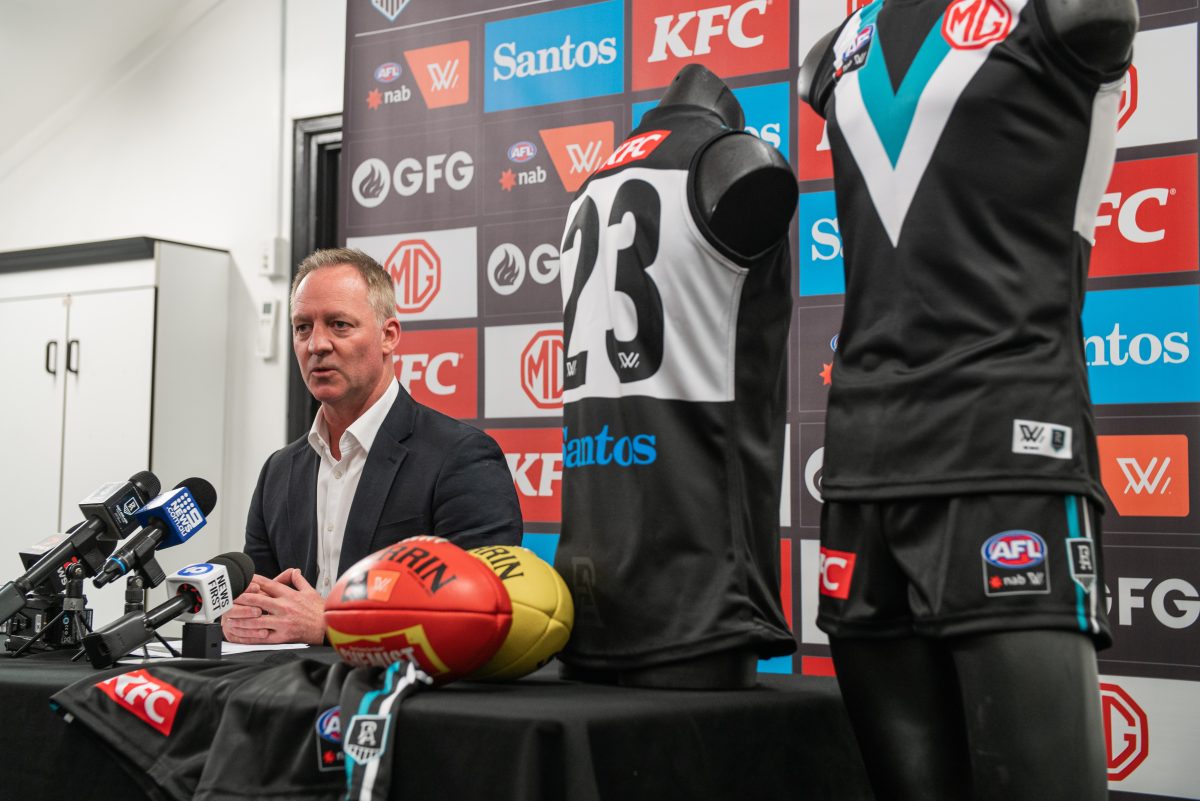Divided we fall: Keeping the faith for Power’s premiership push
Is Port Adelaide flagging under the heavy expectation of “Chasing Greatness”? Michelangelo Rucci talks to the mission statement’s author – now club CEO – about unity, division and direction in the drive for a premiership.


Port Adelaide Football Club CEO Matthew Richardson. Photo: PAFC
Port Adelaide chief executive Matthew Richardson carries one lesson about his football club’s hardcore fans from the so-called “dark chapter” with the tarps covering thousands of empty seats at Football Park in 2010-2012: actions mean much more than words.
Richardson was the Port Adelaide Football Club’s membership manager while the AFL and SANFL sides were brought together ending 15 years of confusion on which team was the “real Port Adelaide”. Independence was secured from the SANFL which had held its AFL licence since 1994, and the escape from Football Park to Adelaide Oval was coming in 2014.
“We had 50,000 fans who had let their membership lapse: 50,000 who had at some stage from the club entering the AFL in 1997 to 2010 had let go of their membership,” Richardson recalled. “We started a campaign asking, ‘What will it take to get you back?’
“The response was, ‘Are you going to be the Port Adelaide I used to know?’ They were judging us by our actions. They held back until we delivered by our actions, rather than how we spoke. Our first actions were to deal with critical issues to again make Port Adelaide what the fans had known off the field.
“By 2011, we reunited the club. At the end of 2012, we backed our football program to the hilt. Our actions were met with membership rising from 30,000 (29,914 by the AFL’s numbers) to 40,000 (39,838). The members were making it clear they would come back if we acted as the Port Adelaide they all knew.”
A decade later, the same theme echoes with Richardson. Now starting his third year as club chief executive, Richardson is wary about surveying or reviewing how the off-field changes at Alberton have significantly refloated the once-perilous business model at Alberton, even if the storyline makes for a sound thesis on sports management.
Reality at Port Adelaide is that the only success club members want to celebrate is wins achieved on the field – not in boardrooms or executive offices.
“I don’t want to deflect (from the disappointment with on-field results that left Port Adelaide with a 10-12 win-loss record and no finals action),” Richardson told InDaily. “The results don’t lie.”
Richardson authored Port Adelaide’s “Chasing Greatness” manifesto that set the club’s on-field ambition at three AFL premierships between 2021 and 2025. Port Adelaide – even with preliminary final appearances in 2020 and 2021 and the minor premiership in 2020 – has repeatedly struggled to advance from “good” to “great” and this year it fell back to less than “good”.
Port Adelaide members and fans want our club defined by only one thing – winning
Off field, there is a different storyline. But can it fill Port Adelaide with pride if the new shelves on the trophy cabinet collect dust rather than premiership flags?
The Port Adelaide Football Club is much stronger than it was in 2012 when its debt-laden AFL licence was at risk of being revoked, rebadged or relocated while the 152-year-old club was sandwiched between the political ploys of the AFL and SANFL.
Membership reached a club record 63,240 this year (with the AFL audit 58,643 – ranked 11th of 18 in the national league). Profit closed at a club record count of $4.209 million last year, with another significant profit on the cards at the end of the football financial year on October 31.
Sponsorship is at club record levels, with major international brands.
Alberton Oval, the club’s home since 1880, is undergoing a $30 million upgrade with the intent of creating a major focal point for the Port Adelaide community.

Alberton Oval. Photo: Tony Lewis/InDaily
Richardson should be proud of these achievements, considering his club was a basket case a decade ago. But he stays reticent to pat himself or his administrative team on the back, particularly in public. No one has ever uncorked champagne bottles at Alberton for off-field success. No one organises reunions to celebrate seasons that ended with the club’s books in the black.
“Port Adelaide members and fans want our club defined by only one thing – winning,” says Richardson.
On the field, the team that won just 18 of 66 AFL games from 2010-2012 has the second-best winning rate of the past decade (131 of 215 matches, with Geelong leading the league with 163 wins in 233).
But there has been no premiership in either the AFL or SANFL since the breakthrough national title in 2004. This is the longest drought in Port Adelaide Football Club history, surpassing the 12-year wait from 1965-1977 when Russell Ebert accepted the SANFL flag saying, “It has taken us a bloody long time, but by geez it’s worth it.”
Today, an 18-year drought is a premiership famine that has those hardcore Port Adelaide fans gnashing (and sharpening) their teeth again. And there is a group – a loud minority – that would like to spit senior coach Ken Hinkley out of their jagged teeth and their club after a decade-long tenure that has failed to deliver a grand final appearance.

Coach Ken Hinkley (centre) with Matthew Richardson. Photo: PAFC
Port Adelaide’s board last month stood resolute to honour Hinkley’s contract for Season 2023, despite the failure to follow up consecutive preliminary final appearances in 2021 and 2022 with a top-eight finals appearance this year. The agitators – the members who ask ‘Are you going to be the Port Adelaide I used to know?’ – wonder what has happened to the club’s ruthless edge that in 1961 and 1987 sacked club greats Geof Motley and Russell Ebert as coaches, to reinstate Fos Williams and John Cahill respectively.
In 2022, there is the understanding of the importance of judging a “football program” rather than just a coach. Despite a “losing” season (with more losses than wins) for the first time since 2016, the Port Adelaide board noted:
- No discontent in the player base that could have easily fractured after starting the season with five losses.
- Player managers insist Port Adelaide is a “destination club” because of the reputation Hinkley has built as a coach who enhances and develops player careers. West Coast forward Junior Rioli is this year’s headline gain after Western Bulldogs midfielder Josh Dunkley preferred Brisbane.
- Key forward Charlie Dixon became runner-up for the 2020 Coleman Medal awarded to the AFL’s leading goalkicker. Ollie Wines has the Brownlow Medal. Others, such as recent Greater Western Sydney recruit Jeremy Finlayson, credit Hinkley’s care for bringing the best out of what had been an inconsistent start to his AFL story.
- Hinkley is highly regarded by his peers, as publicly declared this year by Geelong premiership coach Chris Scott. And there is that paradox that while Hinkley was copping criticism as Port Adelaide’s coach, he also was seen as an ideal candidate for the vacancies that emerged this year at Greater Western Sydney, North Melbourne and still remains at Essendon.
There is strong faith in Hinkley, at least internally. The agitators will say the Port Adelaide board should have sounded out four-time AFL premiership master Alastair Clarkson to make a return to Alberton where he was an assistant coach in the club’s 2004 premiership run.
Despite the unsubstantiated stories during the year that Clarkson had bought property in Adelaide’s western suburbs, there was certainly no chance of Clarkson considering Port Adelaide had Hinkley been sacked – as highlighted with Essendon after the dismissal of Ben Rutten. (And Clarkson’s return to coaching at North Melbourne has this week been overshadowed by disturbing allegations).
While Hinkley carries a greater burden to succeed than he did in 2013 when Port Adelaide’s relevance and value to AFL was in question, Richardson also has his own cross digging deep into his shoulders. Port Adelaide fans want a successful football team, more so than a bigger club.

Richardson’s much-debated “Chasing Greatness” manifesto, that came with his entry to the chief executive office in October 2020 as Keith Thomas’ successor, was to be a pointer for pride and ambition. It runs the risk today of generating derision.
The mission statement set the ambition at Alberton by 2025 as:
- Three premierships in five years – or, as it reads now, the next three AFL flags
- Membership at 100,000. “We want to be the biggest team in town,” says Richardson.
- Debt-free after years of red ink on the Port Adelaide balance sheet.
Rather than pull back from such demanding goals, Richardson has lifted the bar again. “Debt-free” has become “financially powerful”.
Port Adelaide is not alone in publicly declaring mission statements, as did Richmond with its “Winning Together” blueprint in 2010 that set the aspirational target (achieved) with three flags (2017, 2019 and 2020) within a decade, along with signing 100,000 members. Essendon and Fremantle also put on paper its desire for multiple premierships in a short period.
Richmond chief executive Brendon Gale took many hits when Richmond was falling short, particularly in 2016 when the club board faced a rebel group wanting to sack coach Damien Hardwick. But Gale stood firm to his much-lampooned vision, all of which was achieved at Richmond.
Now the same is faced by Richardson and his team at Port Adelaide. “Chasing Greatness” cannot be conveniently erased. And it will raise eyebrows among outsiders who say “the Port Adelaide I used to know” just won flags rather than talked about winning flags. That Port Adelaide, of course, achieved greatness – 36 flags to be precise – in an SANFL State league competition that has no comparison with the demands of a national AFL.
I genuinely believe it has taken us 25 years to rebuild the real Port Adelaide Football Club after a somewhat traumatic entry to the AFL
Richardson has no regret or misgiving for making the “Chasing Greatness” manifesto public and subject to constant audits or ridicule when Port Adelaide falls short.
“It is deliberately bold and ambitious,” Richardson told InDaily. “Our strategic vision started with this question: ‘If we were to build a successful era that matched any in the club’s 152-year story, what would it look like?’ If we are to rival any other ‘great’ era in Port Adelaide history, look at what we have to measure up from our past. Six flags in a row in the 1950s. Nine flags from 1988 to 1999 while we were chasing an AFL entry. So, three premierships in five years.”
In many ways, “Chasing Greatness” raises eyebrows in the same way US president John Kennedy made NASA’s leaders gulp in September 1962 when he wanted a man sent to the Moon and back “before this (1960s) decade is out”. Richardson has no problem with how “Chasing Greatness” creates pressure and expectation from within at Alberton.
“We should embrace expectation,” says Richardson. “Chasing greatness was never going to be easy.”
In his reading file is “Good to Great” by American consultant, researcher and author Jim Collins. He writes: “Greatness is not an end point. It’s a path – a long, arduous, torturous trail of continual development and improving.”
In his review of the world’s greatest sporting clubs, Richardson reflects on German football powerhouse Bayern Munich. “The minute anyone walks into Bayern’s doors, they are told to live with the persistent pressure to succeed,” said Richardson. “That is Port Adelaide. Expectation lives here at Alberton. We have to embrace it. That is what greatness is about – embracing expectation and every challenge that comes with it.
“Some will suggest we set the bar too high, put too much pressure on the players and coaches. We won’t step back from the ambitions we are chasing or massage our expectations to suit the moment. The easiest thing we could do now is lower the bar. That is the last thing we will do. We are not going to wilt.”
Richardson joined Port Adelaide – the SANFL version – as club general manager in 2004. He moved to the AFL unit in May 2008, taking charge of its membership and marketing portfolios. He came from the SA Cricket Association with no Port Adelaide heritage.
“I tell everyone who asks if I grew up as a Port Adelaide fan, that my Mum used to take me to the footy every week; and she was a big Sturt fan!” explains the 51-year-old.
Despite his upbringing in a household that considered Port Adelaide a bitter rival, Richardson is as hardcore as any Port Adelaide fan in a supporter base described by outsiders as a “cult following”. Today, Richardson is as engrossed in the “Port Adelaide way” as deeply as anyone who was cheering the “Magpies” while they achieved greatness with 23 SANFL premierships in 50 seasons from the moment another outsider, Fos Williams, arrived from West Adelaide in 1950.
“I learned Port Adelaide from the ground up and feel fortunate for starting in the SANFL,” Richardson says. “The first event I was part of was the ‘Greatest Team’. Now that is a crash course on Port Adelaide’s legends. I was immediately captured by what this club and its people have built as a successful culture that we protect.”
On picking up the difficult membership portfolio during the “dark chapter” while the tarps were draped abandoned seats at Football Park, Richardson hit on the core problem at Alberton. It was not, as so many kept telling Port Adelaide, the need to broaden appeal to new supporters with more emphasis on teal and less on the club’s traditional black-and-white battle dress.
“There was a focus at the time on growth, broadening our appeal and attracting new people,” Richardson recalls. “All of that is absolutely right, but the problem was it came at the expense of the club’s traditional supporters, the people who had put the club in the AFL in the first place.
Simply, there was confusion; there were two Port Adelaides. The club and our community was divided. The first thing we had to ask ourselves was ‘Who are we?’ To re-unite the Port Adelaide community, we had to be clear with our identity. We had to put our club back together.
“I remember vividly the day I sat down with Russell Ebert and took him through the plan, knowing that if we couldn’t get it past Russell, it had no chance. Russell’s response? He said, ‘It’s just common sense. The club should never have been divided in the first place’. And away we went.”
Today, Richardson describes Port Adelaide as a club “charging forward”. No longer is the club being dragged back by the AFL-SANFL football politics that dragged on for 20 years. He has a strong sense of loyalty to the men who paid dearly in those battles.
“The hard work and sacrifice of the leaders who came before us is ever present in my mind,” said Richardson who was at Alberton during the SANFL-AFL battles that consumed then-president Brett Duncanson and his board. “There have been so many significant moments since 1990 (the most tumultuous year in SA football when Port Adelaide broke ranks to seek a VFL-AFL licence).
“Those moments begin with a board that had the vision and strength to chase and win promotion to the AFL and then win our first AFL premiership. They were followed by leaders who drove us to Adelaide Oval, secured independence of our AFL licence from the SANFL and rebuilt the Port Adelaide Football Club as one club. Then Keith Thomas and David Koch set about recharging Port Adelaide, both on and off-field.
“It was a football-led recovery, ensuring Ken Hinkley and his team had all the resources they needed to build a successful football program. We did some fantastic things during that period to change the way people think about the Port Adelaide Football Club – as a strong, authentic and respected club.
“The COVID pandemic has challenged us like nothing before. We pretty quickly saw an opportunity rather than a burden. We thought, ‘Don’t waste the crisis”. We asked, ‘How do we reset again and continue on the solid foundations left by those who came before us?’ In the most challenging moments of a world pandemic, we put up the framework for ‘Chasing Greatness’.”
Port Adelaide has during Richardson’s time in the Port Adelaide membership department known and overcome its own “pandemic” – the clear out of Football Park in the so-called “dark chapter” of 2010-2012. The much-treasured count of 11-game season-ticket sales was at 12,000 in the darkest hours at West Lakes in 2012. They needed to be at 33,000 on entering Adelaide Oval in 2014 if the move from West Lakes to the city was to be successful financially. They opened at 34,000, with most of the new sales coming from the 50,000 disillusioned fans who had walked away in 2010.
Richardson does lead a bigger Port Adelaide Football Club today with the entry to the now 18-team AFLW.
“And a better Port Adelaide Football Club,” he says, as the club opted for financial growth through China when the AFLW began in 2017.
“China was about thinking big and bold. If we could put on AFL games in Shanghai, we can do anything. We learned how to think big again, how to be brave to do things differently. Commercially, China has been valuable to us. But the invaluable legacy is the thought we can do anything we put our mind to.”
The five-year wait to enter the national women’s league has not been so damaging. The off-field success story in entering the AFLW in the last expansion chapter is Port Adelaide already has the league’s No. 1 team for generating commercial revenue. Port Adelaide’s AFLW membership has passed 4000.
“We hoped AFLW would drive our growth,” Richardson said. “In the past five years, we have gained almost 50,000 new fans. In the first three months of AFLW, we had 30,000. That is huge.”
Richardson also has to negotiate Port Adelaide’s difficult presence in the SANFL where it has a deal – that can be cut on 12 months’ notice – until 2028, when the AFL is expected to have a new national reserves series.
“Development of our players is critical in the AFL competition,” says Richardson whose club is a founding member of the SANFL from 1877.
“If we are to achieve our ambition, we have to build a development program which provides our players with the best possible opportunity to grow and develop as AFL players. Our concerns with the current structure is how all AFL clubs field their second-tier teams in differing State leagues, with different rules on player selection/recruiting from competition to competition. It is highlighted by the inequality across the league. The critical question is how does this limit a player’s ability to learn and develop?
“We take being a foundation club of the SANFL seriously, but Port Adelaide always looks forward and plans for the future. That’s what we’ll continue to do.”
That future vision has Richardson expanding the Port Adelaide Football Club with a sporting centre of excellence and community centre at the spiritual base at Alberton where the club established its home in 1880. This is even greater ambition than his “Chasing Greatness” manifesto.
“The Port Adelaide community is our heart; this is where we get a strong sense of who we are and where we have come from,” Richardson said. “Alberton Oval will always be our home. It will become a centre of high performance with facilities that give us the best chance to win.
“‘Chasing Greatness’ is a strategic vision that is bold and ambitious,” he adds. “Our responsibility as custodians is to further strengthen and position the Port Adelaide Football Club so it is better in the future and in the present has the best chance to win. We will never change our mantra of ‘We Exist to Win Premierships’. To give ourselves the best chance of on-field success, you must build an incredibly strong club and organisation around the football program.
“Look at the AFL clubs that are always competing for premierships. They are united, well run at every level and they just keep giving themselves the opportunity to win. We are not that far off. I genuinely believe it has taken us 25 years to rebuild the real Port Adelaide Football Club after a somewhat traumatic entry to the AFL. That’s real.
“We now have a strong platform to ensure that we progress the club and ensure that the next generation has a club with an even stronger legacy. Our ambition is to build an era of success that adds to the Port Adelaide story – and you don’t do that here by being ‘just good’ or lowering expectations.”
The club that lives to an anthem from an INXS hit – “Never Tear Us Apart” – today finds its greatest challenge is avoiding fracturing over the faith being shown in Hinkley.
“When Port Adelaide was divided before 2012,” says Richardson, “and I have lived on both sides of that divide, the Port Adelaide community was eating itself. Our greatest achievements at Port Adelaide come when we are united.”
Disclosure: Michelangelo Rucci is an editorial contributor to the Port Adelaide Football Club website.




